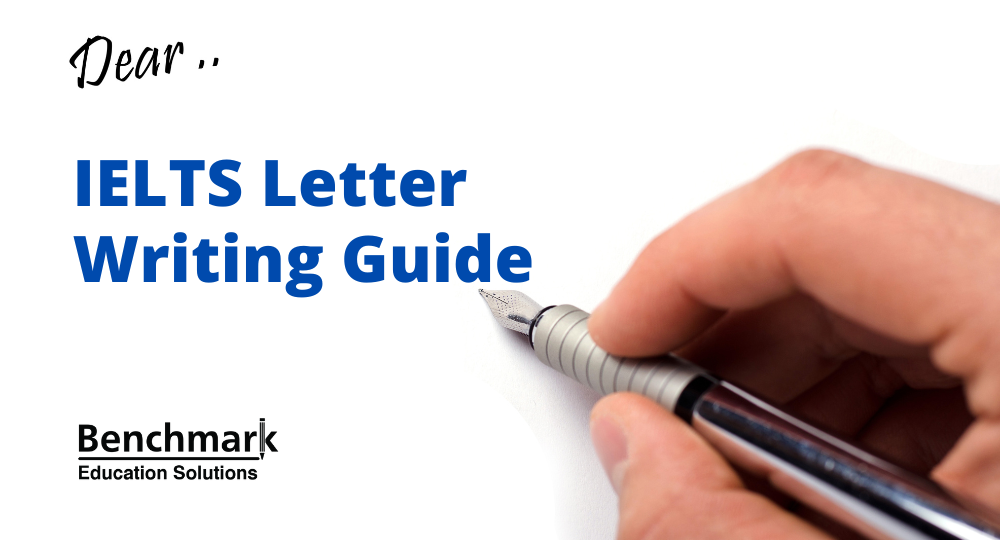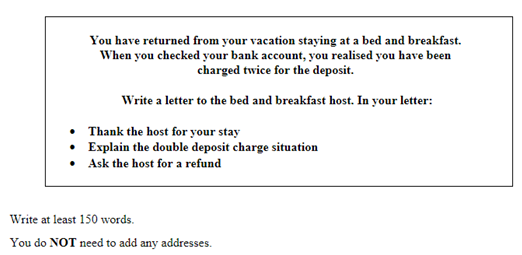
Table of Contents
1. What Is IELTS Writing Task 1?
IELTS Writing task 1 requires candidates to write a letter based on a situation described in the instructions. The instructions provide the key points that need to be detailed in the letter, and it is up to the test-takers to decide on the tone, style and lexical choices for the letter. There is no one right way to write a letter on a given topic, but IELTS Benchmark has gathered useful criteria that can help!
Your letter is marked against the following criteria:
- Task Achievement – how well were the task requirement fulfilled? was all the information included?
- Coherence and Cohesion – how logically laid out and clearly expressed are the ideas in the letter?
- Lexical Resource – how appropriate, accurate and varied is the vocabulary being used (tone, style, register)?
- Grammar Range and Accuracy – how accurate and varied is the grammar being used? Is it appropriately simple or complex?
For more information on these IELTS writing assessment criteria.
The examiner will also be using the scoring bands, based on the criteria above (bands 0 to 9). For more information use this IELTS score calculator.
2. IELTS Letter Task Statement

3. Possible Template for Writing Task 1
- Greeting
- Opening statement (where needed)
- Paragraph 1
- Paragraph 2
- Paragraph 3
- Closing statement (where needed)
- Signoff
- Name
4. Structure of Writing Task 1
4.1 Instructions
Make sure you read those very carefully and look for key words in them to help you focus your letter. The instructions will include:
- The amount of time you should spend on this task
- The context of your letter
- Who you are addressing it to
- Bullet points of the main points to discuss in your letter
- The word count
- Any additional information you should or shouldn’t include.
Ask yourself, what is the aim of the letter? This will define how you will write the letter.
Time: 20 minutes
Word count: Minimum of 150 words (recommended no more than 200 words).
4.2 Greetings
Because you are writing a letter, you want to make sure you include appropriate greetings at the start. Those will depend on the kind of letter you are writing. For instance, if you write to a good friend, you may want to use an informal greeting such as ‘Dear [ first name]’. However, if you write to an employer, you may wish to start your letter with a formal greeting, like ‘Dear Mr/Mrs [last name]’, for instance.
4.3 Opening Statement
In this statement you are explaining why you are writing the letter. You may be writing regarding an issue you experienced with a certain product, or a payment problem you have had, or you may need to send an invitation to someone for an event. The opening statement describes the aim of your letter.
4.4 Paragraphing
Paragraphs are very important for structure. They should each focus on a different idea you wish to express in a logical order. Due to the IELTS letter word limit, your paragraphs must be concise, meaning they contain relevant information only, and are not overly lengthy.
Your paragraphs should also contain a tone, style and language that are appropriate for the aim of your letter. For example, if you are writing a complaint, you may need to use an angry tone and language (e.g. ‘upset’, ‘unacceptable’, ‘disappointed’). If you are writing to thank a friend, you will use a lighter, grateful tone and language (e.g. ‘thank you’, ‘grateful’, ‘kindness’, ‘appreciation’).
4.5 Closing Statement
The closing statement is not always needed, but may be useful, particularly in formal letters. They may help express a certain expectation or a wish to the person reading it.
Example for informal letters: I hope you feel better soon
Example for semi-formal letters: I hope to hearing from you soon
Example for formal letter: I look forward to your response
4.6 Signoffs
Just like greetings, signoffs need to be appropriate to the type of letter and the audience reading it. As such, if you write to a close family member, you may end you letter with ‘See you soon’, for example. If you write a more formal letter to your landlord or your manager, a fitting example of a signoff would be ‘Best regards’. As with greetings, make certain that the signoffs match the style and aim of your letter.
5. Styles of Letters
Different styles of letters may include, amongst others:
- Job applications (formal)
- Complaints (generally formal)
- Requests (any style)
- Apologies (any style)
- Invitations (informal or semi-formal)
- Business-related letters (generally semi-formal)
6. Tips For Successfully Completing Writing Task 1
6.1 Read the instructions and make sure you clearly identify the purpose of the letter.
6.2 Manage your time effectively – you have 60 minutes to complete two writing tasks. It is recommended you spend no longer than 20 minutes on Writing Task 1, so that you have enough time to complete a more open-ended Writing Task 2. Below are suggestions on how to use your 20 minutes:
- 1-2 minutes identifying key words in the instructions and aim of the letter
- No more than 5 minutes planning your letter – make sure all the bullet point ideas in the instructions are clearly mentioned in paragraphs in your letter.
- Write your letter on the answer booklet provided
- Leave 2 minutes to review your work
6.3 Ensure that your letter clearly covers the bullet points in the instructions, while keeping the flow and content natural and appropriate to the situation and the audience it is addressed to (friend, colleague, landlord, employer, etc.). A good idea is to dedicate a paragraph for each bullet point, and connect the paragraph using suitable transitioning language, such as ‘firstly’/‘first of all’, however’/‘but’, ‘therefore’/’so, etc.).
6.4 Pay attention to the aim of your letter: are you writing a complaint? A request? An invitation? Adapt your language, your style and your tone accordingly.
6.5 Grammar must be appropriate to the context and style of the letter (simpler grammar for informal letters, more complex grammar for semi-formal and formal letters). Similarly, decide on suitable greetings, opening lines and closing lines for the type of letter you need to write.
Examples of useful language:
| Greeting | Opening statement | Closing statement | Signoff | |
|---|---|---|---|---|
| Informal
(friend, family…) | Dear first name, | I hope this letter finds you well. I just wanted to write to you to… I just thought I would write to you to… I’m writing to you to… | Thanks again I hope to hear from you soon Keep in touch | With love, Warm regards, |
| Semi-formal (colleague, accountant, landlord (if know quite well)…) | Dear Mr (last name) Dear Mrs (last name) | I am writing to you to… I am writing in regard to | I look froward to hearing from you soon Thank you in advance | Kind regards, Yours sincerely |
| Formal (employer, company director, etc…) | Dear Mr (last name) Dear Mrs (last name) Dear Sir or Madam Dear (full name) To whom it may concern | I am writing with regards to… I am writing to complain about | I look forward to your response Thank you in advance | Yours sincerely Yours faithfully |
7. Keep in mind
7.1 If your letter is informal (e.g. to a friend), you may use contractions (e.g. don’t, won’t, can’t, isn’t, etc). However, if you use semi-formal or formal letter (e.g. to your billing company, your boss, your landlord etc.), you must use the full form (‘do not’ instead of ‘don’t’, ‘will not’ instead of ‘won’t’, ‘is not’ instead of ‘isn’t’, etc.)
Other linguistic differences may include:
| Informal | Formal |
|---|---|
| Some slang | No slang |
| Some idioms | Few idioms |
| Active and passive voices (I received a gif) | Mostly passive voice (the gift was given to me) |
| Simple transition words (but, so…) | More complex transition words (however, nevertheless, therefore, moreover) |
7.2 While the word count states a minimum of 150 words (recommended up to 200 words), do not be tempted to write too much, as overdetailing or adding less important information may distract the examiner from the focus of your letter.
Example: You want to extend the deadline for you rent payment.
Focused example: My current job has reduced my work hours this month, and I may not be able to save as much as I would like to pay the rent on time. I therefore humbly ask for an extension on my rent payment for an additional two weeks.
The message is concise – the cause and consequence (less hours so less saved up money) are briefly stated, followed by a clear, concise, direct yet polite request (extension for rent payment).
Distracting example: My current job has reduced my work hours this month, and I have to save money for food and other bills. I also need to transfer money into my savings account every month which takes away from my rent money. I do not think that I will have enough money to pay for all of that. I humbly ask that you extend my rent payment for an additional two weeks.
While this message describes a similar message, too much detail is provided on the issue, which sounds more like a list of issues than a concern being expressed. The reader may lose interest or feel frustrated by the time they get to the actual request.
Note: The number of paragraphs may vary depending on how many bullet points are provided in the instructions, and how much relevant content you may need to include.
8. Sample Test and Answer

Write at least 150 words.
You do NOT need to add any addresses.
Sample answer:
Dear Sir or Madam,
I am writing to you regarding a deposit transaction issue.
My name is Robin Hood and I stayed at your bed and breakfast for a week. I would like to firstly thank you for a truly fantastic stay. It was relaxing and comfortable – just what I needed. I sincerely appreciate your kindness and serviceability, going above and beyond to meet my expectations.
Upon my return home today, I accessed my bank account and I noticed that I have been charged twice for the deposit on your property. When I booked the room online, the instructions indicated an additional charge for the deposit that would be returned to me at the end of the stay, once approved by the host. Instead, it seems I have been charged double for it.
I am therefore writing to kindly ask for a refund of the second deposit charge to my account. Should you need my bank details once more I am happy to provide those upon your request.
Thank you very much in advance for your response and for your help,
Yours faithfully,
[Name]
(172 words)
Let’s have a look at the criteria and how these have been met in this sample.
| Para | Line | Text |
|---|---|---|
| 1 | Dear Sir or Madam, | |
| 1 | I am writing to you regarding a deposit transaction issue. | |
| My name is [blank] and I stayed at your bed and breakfast for | ||
| a week. I would like to firstly thank you for a truly fantastic | ||
| 5 | stay. It was relaxing and comfortable – just what I needed. I | |
| sincerely appreciate your kindness and serviceability, going | ||
| above and beyond to meet my expectations. | ||
| 2 | Upon my return home today, I accessed my bank account and | |
| I noticed that I have been charged twice for the deposit on | ||
| 10 | your property. When I booked the room online, the | |
| instructions indicated an additional charge for the deposit | ||
| that would be returned to me at the end of the stay, once | ||
| approved by the host. Instead, it seems I have been charged | ||
| double for it. | ||
| 3 | 15 | I am therefore writing to kindly ask for a refund of the second |
| deposit charge to my account. Should you need my bank | ||
| details once more I would be happy to provide those upon | ||
| your request. | ||
| Thank you very much in advance for your response and for your | ||
| 20 | help. | |
| Kind regards, | ||
| [Name] |
9. Structure Analysis
Greeting: line 1
Opening line: line 2
Paragraph 1: thanks for the stay
Paragraph 2: explaining the double charge situation
Paragraph 3: asking for a refund
Closing line: lines 19-20
Sign off: line 21
Name: line 22
The style here is formal as this was not so much of a complaint, but more of a request to rectify a mistake. No contractions were used and there is a mixture of active and passive voices (particularly in paragraph 2, lines 10-14).
Task Achievement
– how well were the task requirement fulfilled? was all the information included?
Paragraphs 1 2 and 3 cover all bullet points in the instructions, in the same order as indicated in the instructions.
Coherence and Cohesion
– how logically laid out and clearly expressed are the ideas in the letter?
Lines 1 and 19-21: The letter begins and ends with greetings.
Coherence
Paragraphs 1, 2 and 3: Each bullet point idea from the instructions is expressed in a separate paragraph, starting with an introduction and thanks, moving onto explaining the issue, and ending on a request to solve the issue.
Cohesion
The language used demonstrates an order of ideas and events:
Line 4: ‘firstly’, indicating the first point that is being made
Line 8: ‘upon my return’, referring to an event that occurred afterwards
Line 15: ‘therefore’, expressing a conclusion.
Lexical Resource
– how appropriate, accurate and varied is the vocabulary being used (tone, style, register)?
There is a balance of terms and phrases (in green) that are more commonly used, and some which are a little less usual, yet convey meaning with great accuracy:
Line 1: ’Good afternoon’ (appropriate start greeting for a semi-formal letter)
Lines 4 and 6: ‘truly’ and ‘sincerely’ respectively (good synonyms that express very similar meaning without repetition)
Line 6: ‘serviceability’ (helpfulness)
Lines 6-7: ‘going above and beyond’ (making extra efforts)
Line 8: ‘upon my return’ (formal – when I got back)
Lines 12-13: ‘once approved’ (when agreed upon)
Line 19: ‘Thank you very much in advance’ (good end greeting)
Line 21: ’Kind regards’ (good final greeting)
Grammatical Range and Accuracy
– how accurate and varied is the IELTS grammar being used? Is it appropriately simple or complex?
There is a range of tenses and structures, both simple and more complex.
Line 3: ’stayed’ (past tense)
Line 8: ‘Upon my return… I accessed’ (consistent use of past tense)
Line 10-12: ’When I booked…the instructions indicated… that would be returned’ (use of ‘when’ as a conjunction and consistent use of past tense to describe a past event)
Line 13: ‘instead’ (expressing contradiction)
Line 13: ’it seems’ (describing something which appears to be true)
Line 13: ’I have been charged’ (use of present perfect)
Lines 16-17: ’Should you need… I would be happy to’ (consistent use of the past tense following ‘should you’)


